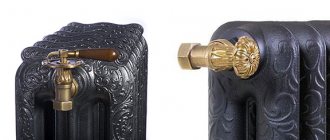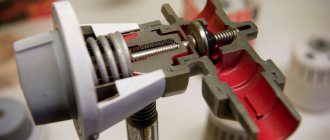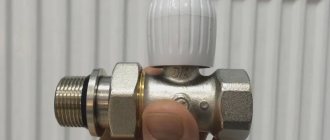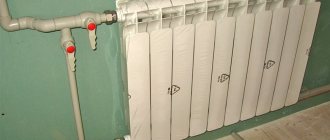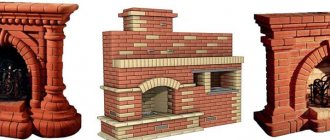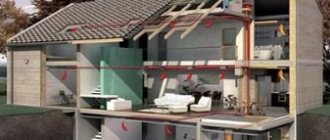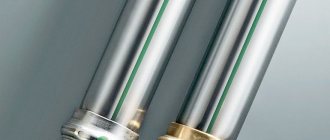Ball valves are one of the types of shut-off valves. The role of a locking element in structures of this type is played by a metal ball. The devices have a long service life and do not require regular maintenance. The main distinguishing feature is the minimum time required to shut off water or gas. And thanks to their small overall dimensions, they are installed in places where the use of standard valves is impossible due to limited space.
Marking on the ball valve body
Manufacturers must put a number of markings on the outer sides of the ball valve body (see Fig. 13). All markings must be as clear as possible. Vague and unclear markings may indicate worn-out forms or that the buyer is looking at a cheap fake.
Rice. 13. Marking on the body of ball valves
The following is usually indicated on the ball valve:
The emblem (trademark, mark) of the manufacturing company is a mandatory attribute of a quality product. DN is the nominal diameter, which can be indicated in millimeters (15, 20, 25, 32, 40 and 50 mm), or in inches (for example, ½, ¾, 1, 1 ¼, 1 ½ and 2”).PN – operating pressure in bar. Depending on the diameter and design features of a particular product, this value can range from 15 to 40 bar. The body material is brass grade according to EN. Product production date – 04/11.
Principle of operation
Different types of water taps have their own design features, but they have the same operating principle:
- if water supply is required, the user activates an external device for this, for example, in sensor devices it is necessary to bring your hands to the sensor, in valve structures special caps are used on the valves, in single-lever taps you need to raise the flag upward;
- after performing these manipulations, cold and hot water begins to flow from the pipes, which is mixed in the faucet structure itself, so at the outlet the user has a liquid of the required temperature;
For a kitchen sink, it is best to choose a long valve tap with a high curved spout Source kabel-house.ru
- to adjust the temperature, an external device of the plumbing fixture is again used: the flag is moved to the required side, the valves are screwed or unscrewed;
- touch and thermostatic taps contain a special element that independently regulates the temperature before serving, that is, the equipment can be pre-set to the required temperature.
Why are shut-off and control devices needed?
More recently, batteries were connected to the rest of the heating system without any additional elements. Today, the installation of almost every radiator automatically involves the installation of taps. The reason for such changes is related to savings and the possibility of unplanned situations.
If the seal of the radiator is broken, it leaks, or becomes clogged, you can simply turn the valve, blocking the access of water, and remove the battery for repair or cleaning. To do this, you don’t even have to drain the water from the entire system. Such taps are called shut-off taps. They are installed on pipes through which fluid is supplied and discharged. In open mode, they do not interfere with the free flow of water, but in closed mode, they completely block its supply.
The tap is necessary to remove air accumulated in the heating system. Usually it is called "Maevsky".
Some taps allow you to adjust the heating temperature of the heating system. With their help, you can save on heating by lowering the heating temperature of the radiators or turning them off if it’s warm outside. This is true for both private houses and apartment buildings.
What types of ball valves are there based on body material?
3.1. Brass ball valve.
Brass ball valves
The main advantages of brass valves:
- low price; — short delivery times; — good performance characteristics for water and gas; - resistance to mechanical stress.
The main disadvantages of brass taps:
— a small number of diameters, mainly produced from DN 8 to DN 100 mm; — lack of welded design; — unstable operation at temperatures above 200 degrees C; — impossibility of stable operation on petroleum products.
Steel ball valves
The main advantages of steel cranes:
- low price; — large selection of models from different manufacturers; — short delivery times; — good performance characteristics for hot water and gas; — resistance to mechanical stress; - wide model range.
The main disadvantages of steel cranes:
— unstable operation at temperatures less than -40 degrees C; — difficulties with long-term operation in cold water supply systems; — impossibility of operation in mildly aggressive environments.
3.4. Ball valve made of stainless steel (stainless).
The main advantages of stainless steel taps:
— a wide range of working environments; — possibility of operation at temperatures down to -60C.
The main disadvantages of stainless taps:
- high price; — narrow model range, mainly produced from DN 8 to DN 300 mm; — long delivery times for most cranes.
Cast iron ball valves
3.6. Plastic ball valve
Plastic ball valves
The main advantages of polypropylene taps:
- durability comparable to brass; — price; - light weight.
The main disadvantages of polypropylene taps:
- Possibility of installation only on plastic pipes.
Final rating
I think that now you are eager to find out what the final rating will be for this comparison. Therefore, we immediately move on to the final table.
Final rating
- And the first place is taken by the Bugatti Oregon crane.
- 2nd and 3rd places were shared by Rub and Giacomini.
- 4 - Itap,
- 5 - Icma. These taps are almost identical, both externally and by comparison. That's why they ended up next to each other in the ranking.
- The 6th place was taken by the Herz crane.
- Closely behind him in seventh place is General Fittings.
- In eighth place is IVR.
- Ninth place goes to Bonomi.
- And the ranking is completed by FIV Perfecta.
SavingSavedRemoved 1
Back
Modernization of heating units and elevator points
MORE
Characteristics
When choosing a crane, you should pay attention to its key characteristics. The right choice will affect the duration of its operation
Patency
The main elements of a ball valve are a ball and a pipe. In this case, the diameter of the ball passage hole must correspond to the diameter of the pipe. When open, the valve itself is a solid cylinder. If there is no narrowing between the pipe and the tap, then such a valve is called full bore. It has a number of advantages
:
- there is no loss of water pressure;
- long service life;
According to its characteristics, a full bore ball valve can be considered the best. Despite this, they have disadvantages: significant cost and weight. In order to save money, the passage of the ball valve may be narrower. It is made symmetrically or there is a narrowing on only one side. If the design is asymmetrical, then the narrowing is made in the direction of water flow. Thanks to this, metal consumption becomes less. Less effort is required to control the flow. But their cross-country ability is already lower.
Thread and pressure
Ball valves are attached to the pipe by screwing onto the thread. It can be either in the form of a nut (internal) or in the form of a bolt (external). The latter is correctly called a fitting. The tap is called by the type of thread: “nut-nut” (both threads are internal) or “fitting-nut” (one thread is external, the other is internal).
The operating pressure of the elements of the plumbing system is measured in atmospheres. One atmosphere - 1 bar. The corresponding designation on the tap is PN. For example, PN20 means a maximum pressure of 20 bar. As a rule, in ordinary home structures it does not exceed 7 bar during normal operation. But overloads
, therefore the locking device must have a safety margin. The minimum PN value for taps is never lower than 16.
Diameter
The cross-sections of the pipe and the tap do not match to the nearest millimeter. Typically, store salespeople understand what a customer means when they say, “I need a faucet for a half-inch male pipe.” But in order not to rely on the seller, it is better to know exactly what pipe sizes and diameters are used in conventional plumbing systems. The diameters of ball valves comply with certain standards.
The most commonly used pipes in homes are ½, ¾, 1 and 1¼ inches. These sizes correspond to 15, 20, 25 and 32 mm, respectively. They are measured by outer diameter. In order to find out the diameter of the pipe, you can measure it with a caliper or determine
indirectly along the circumference. The circumference must be divided by 3.14. But it should be taken into account: if the pipe is steel, then there may be several layers of paint on it, which leads to a slight thickening. Therefore, such measurements should be reduced to the nearest size.
On the valves themselves it is most often written what pipe diameter they are intended for. Full bore valves have one feature: their thread always matches the diameter of the pipe. This ensures that there are no narrowings of the passage, and, as a result, there are no hydraulic losses. For other taps, depending on the thickness of the pipe, the diameter may vary.
Comparison of wall thickness.
To do this, I performed autopsies on all samples. And I measured the wall thicknesses in four places: two of them are the thicknesses of the external and internal threads. 3 is the place under the ball and the fourth place is the connection of two half-bodies.
The best indicators in the following parameters have:
- in thickness A1 the leaders are Rub and General Fittings.
- According to A2 - Giacomini.
- By A3 Giacomini, Itap, RUB and Herz.
- And on A4 - Herz.
In total, at the last stage, Giacomini, Rub and Herz received the most points.
The smallest are IVR and FIV.
Application area of ball valves
The scope of application of ball valves is quite wide:
It is formed during beer production during fermentation. This is why beer cannot be “knocked”. Pressure: The bound carbon dioxide creates pressure that prevents the beer's natural carbon dioxide from escaping, transporting the beer from the barrel to the tap. The operating pressure is set at the intermediate pressure regulator.
Pressure reducer: measures cylinder pressure from approx. 60 bar to max. the permitted downward pressure is adjustable. It makes sense to set the operating pressure required for a particular line or type of beer not with a pressure reducer, but with an intermediate pressure regulator.
What types of ball valves are there by type of control?
- these are cranes with a mechanical gearbox installed on them. The gearbox must be installed on all valves with diameters over 300 mm, as well as on valves with a smaller diameter, where it is necessary to ensure smooth opening of the ball valve.
— these cranes with electric drives installed on them are used for remote control of technological processes, as well as for emergency closure of pipelines.
Ball valve with pneumatic drive
- these valves with pneumatic drives installed on them are used for remote control of technological processes, as well as for emergency closure of pipelines in explosive areas in which the installation of an electric drive is unacceptable.
Operating principle of a ball valve
Ball valves are designed to completely shut off the working flow and are not applicable to regulate it
.
Replacing the ball valve will not be necessary for many years if you use it for its intended purpose and according to the rules set out in the instructions.
Installation: There is a difference between flat, basket and combination fittings. Accordingly, there are different types of taps. Khan: There are different types of cranes. It is often recommended to use an expansion valve. Keg: stainless steel keg, rack permanently installed.
Compensator: The compensator valve has an elongated body, called the so-called. It forms an annular gap in the pipe, the size of which can be adjusted with a small lever. In this way, the valve can be adapted to different dosing ratios by changing the volume flow.
The operating principle of a ball-type valve is based on shutting off the working flow by means of a locking element, which is a ball with a through cylindrical hole.
When the ball rotates around its axis, which is perpendicular to the stationary body of the crane, access to the work flow is blocked or opened.
Regarding the shape of the hole, it is not always round (rectangular, oval, trapezoidal). The size (diameter) of the opening of the locking element also varies depending on the application of the tap and the pipeline network.
Cooling: The supplied drum must be pre-cooled immediately and for a sufficient time to the selected and continuously maintained temperature. Line: Beer lines should be laid so that they can start empty on their own. They should be kept as short as possible. The beer pipe must be cooled along its entire length.
The quantity depends on the length and cross-section of the pipe. This beer should not be offered to the customer as it is no longer of the same quality as barrel beer. O-Ring: The seal in the discharge head that separates the beer path and the gas path from each other and from the outside world. Damaged O-rings must be replaced as otherwise the appliance will trap or risk escaping gas into the room.
The closing element of a ball-type valve, depending on the purpose and dimensions of the shut-off valve, can be sealed mainly in two ways.
Namely:
- ball on supports - for large diameter cranes;
- floating ball – for small cranes.
Sometimes valves with additional sealing rings are also suitable.
Cross Section: Beer lines available with different internal diameters
Important: the nominal diameter must be constant along the entire length of the pipe, otherwise the valve will fail and mechanical cleaning will not be possible. Cleaning: Parts that come into contact alternately with beer and air must be cleaned daily and sanitized with each drum change
The beer line should be chemically cleaned weekly. Even when commissioning an external specialized company, the landlord is responsible for cleaning.
Closing and opening of ball valves is done by turning the handle 90°.
What are the types of ball valves?
These are two-way ball valves in which the ball design allows for regulation of the flow of the working medium.
- these are two-way ball valves with an extended stem designed for installation on underground communications with the ability to open or close the valve through a carpet installed on the street.
- These are ball valves designed for mixing liquid (T-port) or distributing flow (L-port). Such taps are widely used for installing pressure gauges and pressure sensors, as well as in complex technological processes.
- These are two-way ball valves with the ability to connect a temperature sensor. These ball valves are widely used in the installation of residential heat meters.
Ball valves - which ones are better?
Ball water valves are used to regulate the temperature of heating batteries. They can be installed on each battery, on the riser of the entrance to your apartment or in another place.
Ball valves for water of various purposes and sizes are produced by the famous Italian company Bugatti. The list of its products:
- corner water taps;
- direct cold and/or hot water taps;
- taps with “American” (cap nut);
- ball valves with an automatic release of air or a small amount of water - drainage machines or Mayevsky taps;
- ordinary water taps;
- taps equipped with a particulate filtration device, etc.
What sets Bugatti cranes apart from the cranes of most competitors is the ability to carry out minor repairs.
Most taps must be disposed of after they start leaking due to wear of the ball sealing element. Italian faucets solve this problem by turning the gland nut. This allows you to get a “closed/open” resource of up to 20 thousand cycles.
The Italian company VALTEC has been paying a lot of attention to consumers of its products in Russia and Ukraine for more than 10 years. The company's products are designed for fairly harsh operating conditions in the water supply and heating networks of our countries.
The company's ball valves have an increased service life.
The controls, reinforced in thickness and working clearance, are supplemented with burn protection in the form of a plastic coating (PVC - polyvinyl chloride) and allow you to turn the tap after the deposition of a large amount of substances harmful to its operation.
The cranes have passed the necessary certification in Ukraine and Russia.
The well-known company FAR from Italy produces products for Russian consumers that are adapted to the requirements of Russian regulatory documents and harsh working conditions.
One of the products is FAR ball valves. They are:
- with a built-in thermometer and/or temperature measurement sensors;
- with an inch thread, a red or blue handle in which you can install a thermometer;
- with an American union nut and a PRESSFAR press connection, equipped with a handle with the ability to place a thermometer in it;
- full bore with metric thread and red butterfly handle, connection with special ends to different pipelines is possible.
One of the oldest Italian companies, RMB, has been producing fittings and components for water supply and heating for almost 60 years. The company prospectus contains all the necessary equipment for economical and comfortable operation of heating systems:
- fittings for water heating radiators;
- ball valves with magnetic sludge separators;
- self-cleaning taps with magnetic filters;
- full bore ball valves from 0.5 inches to 2 inches;
- standard bore ball valves of different diameters with inch threads;
- check valves for pipeline systems;
- ball valve with a check valve built into the design and much more. etc.
The products of the famous West German company Honeywell have been produced for many decades. For water supply and heating systems, the company also produces ball valves for working with automatic control systems.
These devices are an electrically driven shut-off and control mechanism installed on the ball valve body.
The Honeywell automated ball valve has the following characteristics:
- control as part of the Hometronic Manager system;
- nominal size – 20, 25, 32 mm;
- nominal capacity, cubic meters m/h – 41, 63, 123;
- operating voltage, V – 230.50 Hz;
- turning time “open/closed”, sec – 30.
We hope that this information will help you make the right conclusion about which ball valves are better.
A little history
They were familiar with centralized water supply in ancient Egypt, Hellas, and the Roman Empire. Roman aqueducts still exist in Italy, Spain and Germany.
Interesting! An aqueduct is the name given to the oldest colossal stone structure for supplying water to major European cities, built during the Roman Empire.
Some of them are still used today for their intended purpose. Such a mass of water flowing into ancient cities had to be managed. This is how the first samples of shut-off and water fittings appeared. On the island of Capri, archaeologists discovered ancient brass and bronze cork valves. These are the world's very first models of shut-off valves, predecessors of valves, ball and water taps.
The next impetus for the rapid development of gates and valves was the invention of the steam engine. The need to control water supply and control steam has led to the development of reliable gate valves and adjustable spring-loaded safety valves.
Some technical solutions have not lost their relevance in our time. In the twentieth century, utility networks began to be equipped with butterfly valves, diaphragm valves and ball valves. Today, the development of shut-off valves is moving in several main directions:
- durability;
- reliability;
- manufacturability;
- cost reduction.
Varieties
Ball valves are gradually replacing other common types: sliding, conical and cylindrical. Their basis is a ball, which is used as a locking element. During rotation, the contact of the moving element with the coupling seals remains unchanged. Water passes through due to the fact that a hole is drilled inside the ball. Such taps are used in domestic heating and water supply systems.
There are several types
ball valves:
- welded;
- polypropylene;
- coupling;
- coupling full bore.
Welded and flanged
Weld valves
are secured by welding, making it impossible to dismantle them. Flanged ones are used in wide diameter pipes. When installing them, additional gaskets are installed to seal the joint. Due to their high sealing properties and support for high pressure operation, they are used in gas and oil pipelines. They are also widely used in urban water supply systems.
Polypropylene
Polypropylene valves are made from polyethylene and polypropylene. They are widely used in aggressive environments where metal structural elements degrade very quickly. They are subject to deformation from hot water, so they try not to use them in heating systems. In domestic conditions, valves made of polypropylene with a metal shut-off element are still used.
During installation, they are immediately welded to the plastic pipe. It turns out to be such a hybrid
option: polypropylene, welded. They can already be used in heating systems. Such valves have become widely known relatively recently, thanks to the widespread installation of heating and water supply systems made of polypropylene.
Coupling
Union valves are used for narrow
pipes
Their diameter does not exceed 2 inches. Being compact, they are located in a wide variety of water supply systems. The coupling tap is most common in domestic structures. To shut off the flow of water, simply turn the valve handle. In industrial installations they are made of steel. A more economical material is suitable for household needs: brass. Whatever implementation option is chosen, the key advantages
associated with the use of a ball element remain common to them:
- high reliability;
- ease of operation;
- rust resistance;
- tightness;
- ease of installation.
The full bore version of the coupling valve avoids bottlenecks in the passage of water flow. Structurally, it is wider and the hole in the ball corresponds to the internal diameter of the pipe. It costs more and weighs more.
Structurally, the valves consist
from the following elements:
The handle is made of nickel. It is made both in the shape of a butterfly and in the form of a long lever. In the second case, an additional plastic shell is put on the handle. It is especially important on hot water taps: it acts as a heat insulator. The wedge-shaped nut that secures the fitting is made of steel.
The body itself is made of brass. It provides long lasting
service life and is able to withstand the pressure of domestic water supply systems. The brass body, unfortunately, is not always made only from its alloy. Cheap specimens often contain impurities, and they can simply crumble over time. The outer part is plated with nickel. Therefore, high-quality taps do not always have the yellow color characteristic of brass.
Teflon is used as a seal
. The most expensive models can also use butadiene rubber as a material. The locking ball itself is diamond ground. The inner part is drilled in the shape of a cylinder. It is the wide opening in the cylinder, comparable to the inner diameter of the pipe, that ensures good maneuverability.
In one of the positions, the ball rotates in such a way that its inner cylinder is located in the direction of the water flow, creating an almost flat inner surface of the pipe without bends. In another, it completely blocks water circulation. Insulation is ensured by high-quality joining of the polished surface and the sealing ring.
Briefly about the main thing
After you have described what kinds of water taps there are, you need to determine the main purpose of the purchase - what exactly this or that model is needed for. Taking this into account, the shape of the product, material of manufacture, design and other important points are determined.
Recommendations for choosing a crane:
- Material of the body and internal elements. Today on the market you can most often find devices made of materials such as brass and bronze - these are the highest quality and most durable devices. Silumin products do not have a long service life, the same applies to the plastic filling of the faucet.
- Design. Double-valve products are usually chosen for classic interiors, single-lever ones are characterized by ease of use, and touch and thermostatic ones will appeal to connoisseurs of new products and comfort.
- Form. For the kitchen, it is best to choose taps with a curved spout; for the bathroom, short models. Medium-length items with a slight bend fit perfectly into the washbasin.
- Fastening method. Faucets can be floor-mounted, wall-mounted, mortise-mounted, built-in - this will depend on specific preferences and the location of future installation.
- Maintainability. The most durable are modern touch taps and products with a thermostat. It often happens that the valve on a two-valve device rotates, and on single-lever devices the silicone seals fail.
- Dimensions. Connecting elements are indicated in inches, so it is advisable to find out this parameter in the store. The diameter of the tip is also important - the liquid pressure will depend on it.
Attention! When purchasing, you also need to pay attention to the aeration nozzle - the more holes, the better the water is sprayed.
Today, faucets in stores are available in a huge assortment, this allows all customers to choose the model and design that best suits their specific needs. By following all the rules for operating shut-off valves, you can extend their operating time.
Advantages of ball valves
Ball valves are very compact and at the same time very practical, and also attractive from an aesthetic point of view. They are convenient to use; you can instantly block access to the working flow by simply turning the handle 90°, which is especially important in case of small sudden accidents, such as a gas leak or a water pipe leak.
For butterfly valves, flow is controlled by a disc rotating in the flow path, which is located on a central axis. As with ball valves, positioning time is short as only a quarter turn is required to fully open and close the valve.
Butterfly valves are characterized by simple structure, light weight and compact design. Their installation dimension is often very short, so they have significantly lower pressure loss compared to shut-off valves. The materials used on the disc and seal may limit their use in higher temperatures and some liquids. Butterfly valves are commonly used for water and air applications and in applications with large pipe cross-sections.
Among other things, ball valves are highly wear-resistant and are made from materials that are not subject to corrosion. They tolerate interaction well with aggressive environments.
In addition, they are quite affordable in comparison with analogues for this purpose. Thanks to all these advantages, ball valves have become leaders in the shut-off valve market.
Shut-off valves are suitable for a wide range of applications and, depending on the design, can be used for both shut-off and control purposes. In this type of valve, the flow capacity is determined not only by the cross-section of the valve seat bore, but mainly by the valve lift. The advantage of check valves over other check valves is that even with the valve partially open, there is less risk of damage to the valve seat and check valve. Among the various types of check valves, especially needle valves are well suited for flow control.
Weight
This parameter is also important, and therefore the maximum number of points here is 4. Weight shows the reliability of the housing design. Namely, the housing absorbs all mechanical loads from the pipelines. At this point there will be a separate table and several columns. This is the weight according to the passport, by the way, it’s strange for me, but few manufacturers indicate this information in the passport.
Next - the actual total weight, deviation in one direction or another, the weight of the crane without the butterfly, the weight of the butterfly and the weight of the body.
| Model | Total weight per passport | Total weight is real | Deviation, % | Weight without butterfly | Weight butterflies | Case weight without parts | Total points |
| IDEAL-0930012 | — | 184,51 | — | 173,81 | 10,7 | 130,95 | 3,5 |
| OREGON-03070051 | 187 | 192,83 | + 3,1 % | 181,23 | 11,6 | 132,82 | 3,5 |
| 7100M2N040400A | 178 | 177,32 | — 0,4 % | 165,70 | 11,62 | 122,52 | 3,25 |
| EVERMID- 191905008 | — | 147,64 | — | 138,75 | 8,89 | 92,87 | 2,5 |
| R254X003 | — | 189,38 | — | 173,12 | 16,26 | 140,77 | 4 |
| Perfects - 8367R004 | 151 | 148,89 | -1,4 % | 129,46 | 19,43 | 89,78 | 2,25 |
| S90D26 | — | 207,43 | — | 194,94 | 12,49 | 142,29 | 4 |
| KV2162M | 190 | 189,83 | -0,1 % | 173,69 | 16,14 | 131,50 | 3,5 |
| Tamigi - 760700 | — | 151,02 | — | 138,21 | 12,81 | 95,99 | 2,5 |
| 87351AD11 | — | 195,07 | — | 182,83 | 12,24 | 138,33 | 3,75 |
Total
- The Rub tap has the heaviest weight - 207 grams.
- Next are ICMA, Bugatti, HERZ and Giacomini.
- IVR has the lightest sample.
In terms of deviation, none of the samples has a deviation of less than 2%. And the Bugatti crane is even in the black at 3.1%. Weight without the bowtie - and again Rub, ICMA, Bugatti are ahead. But Itap approached Herz and Giacomini. The last thing on the list is not IVR, but FIV. Since his butterfly weighs almost 20 grams.
Accordingly, the faucet body without a butterfly will be much lighter. And at the end of the comparison is the weight of the clean case, without all the parts and components.
Screenshot from video 8 min
And here we see that Rub is no longer the only leader. It was joined by a Giacomini crane. And the difference between them is only 1.5 grams. In third place is ICMA. The lightest cases are from Bonomi, IVR and FIV.
What else is worth paying attention to
- A new product on the ball valve market is the American ball valve. It allows you to remove the radiator without special equipment or calling a technician, for example, during repairs.
- Ball valves for heating systems differ in the type of handles. There are two types: joystick handle and butterfly handle. Joystick handles must be installed at a considerable distance from each other, otherwise using them will become a problem due to the massive handle. Butterfly handles are typically used for small diameter faucets.
- Another important component material is clamps - fastenings for heating pipes. Today they are available in different sizes, depending on the diameter of the pipes. Clamps are made of plastic or metal. Plastic clamps ensure the mobility of the pipe, and they are also relatively cheap (from 4 rubles per piece). Metal clamps provide a more durable connection, but are much more expensive (from 15 rubles per piece).
Important
It must be remembered that even the smallest parts must be installed by craftsmen with special education and knowledge in this field. Only then will your home always be warm and cozy.
Our company offers you ball valves from leading manufacturers at affordable prices. The company's specialists will select the ideal components for your heating system.
Dispute on the topic “What is the correct way to say: ball valve or ball valve?” will arise more than once, so let’s clarify right away: in the singular it is correct to say ball valve, and in the plural - ball valves. However, at the time of writing this article, auto-filling Yandex and Google when typing “ball valve” first gives the option “ball valve” - since this option is more often used by technical specialists in “professional jargon” - personally, “ball valve” is closer to us. For simplicity of presentation, we will consider these phrases identical (from a technical point of view) and leave this dispute to our beloved teachers of literature and the Russian language. So, in this article we will try to consider in detail all the types of ball valves and which ball (ball) valve is best to choose from the whole variety of ball valves.
1. What is a ball valve? 2. What are the advantages and disadvantages of ball valves? 3. What types of ball valves are there based on body material? 4. What types of ball valves are there by type of connection? 5. What types of ball valves are there according to the type of passage? 6. What types of ball valves are there by body type? 7. What types of ball valves are there by type of seal? 8. What types of ball valves are there? 9. What types of ball valves are there by type of control? 10. What parameters are important when choosing a ball valve? 11. Where to buy a ball valve (ball valve)? 12. What is better to install a ball valve, a butterfly valve, a gate valve or a gate valve?
Rating of the TOP 15 best sink faucets for 2021-2022
| Place | Name | Price |
| TOP 4 best sink faucets for 2021-2022 by price/quality | ||
| 1 | Grohe BauClassic 23162000 | Find out the price |
| 2 | VitrA Minimax A41984EXP | Find out the price |
| 3 | Grohe Eurostyle Cosmopolitan 3246820E | Find out the price |
| 4 | Lemark Unit LM4506C | Find out the price |
| TOP 3 best inexpensive sink faucets | ||
| 1 | Grohe Euroeco 32734000 | Find out the price |
| 2 | VIDIMA Orion B4223AA/BA001AA | Find out the price |
| 3 | KAISER Merkur 26011 | Find out the price |
| TOP 3 best single lever basin faucets | ||
| 1 | Grohe Concetto 32204001 | Find out the price |
| 2 | Hansgrohe Focus 31517000 | Find out the price |
| 3 | Grohe Eurocube 23132000 | Find out the price |
| TOP 3 best premium sink faucets | ||
| 1 | Lemark Atlantiss LM3209C | Find out the price |
| 2 | Hansgrohe Focus 31518000 | Find out the price |
| 3 | IDDIS Vane YA16177C | Find out the price |
| TOP 2 best faucets with thermostat for the kitchen | ||
| 1 | Lemark Thermo LM7736C | Find out the price |
| 2 | AM.PM Inspire 2.0 F50A02400 | Find out the price |
Weak sides
Despite many positive qualities, ball valves have their disadvantages. Water from the water supply system may contain various impurities in the form of scale and rust. If the tap is fixed in one position for a long time, it begins to become clogged with slag. Even salty substances
sediments. In order to knock layers off the ball, it must be turned at least once a quarter.
The quality of the faucet is also not always possible to check when purchasing. Some specimens begin to leak over time. As a rule, this is due to a poor-quality oil seal. It can be replaced, but often the fixing nut turns along with the valve. In addition, the crane can only be operated at positive temperatures. If the water in the tap freezes, the tap itself may simply burst.
Tips for installation and operation
Before installing the tap, wipe the threads with a rag and clean them from dust, shavings, and dirt; the old thread should be driven out with a die - this will clean the thread from rust and deposited calcium and magnesium salts. First, the faucet is tried on - screwed on without FUM tape and the number of turns is remembered. The direction of winding the tape must coincide with the direction of winding the reinforcement. Screw the tap on the same number of turns as during fitting. The minimum number of turns is 4. Then the bend is screwed in in the same way or the nut is screwed on the other side.
The system is filled with water and tested; if there is a leak, the connection will have to be unscrewed, a sealant (FUM) added, tightened and tested again.
During operation, it is necessary to close and open the tap at least once a month - this will remove salt deposits from the ball. The shutter cannot be kept partially open - this will lead to premature wear of the shutter. The handle position must be either open or closed.
What types of ball valves are there by type of seal?
PTFE (fluoroplastic, teflon)
– a temperature-resistant polymer that ensures stable operation in hot and cold water, technical oils, hydrocarbon mixtures (petroleum products, natural gas), steam (up to 150C). Operating temperature range from -10C..+150C, maximum permissible temperature -40C..+200C.
Metal to metal
- This is a seal in which the valve body and ball are in contact with each other without soft seals.
The main advantage of metal seals is their resistance to high temperatures. The main disadvantage can be considered the difficulty of ensuring tightness class A. (no votes yet)
